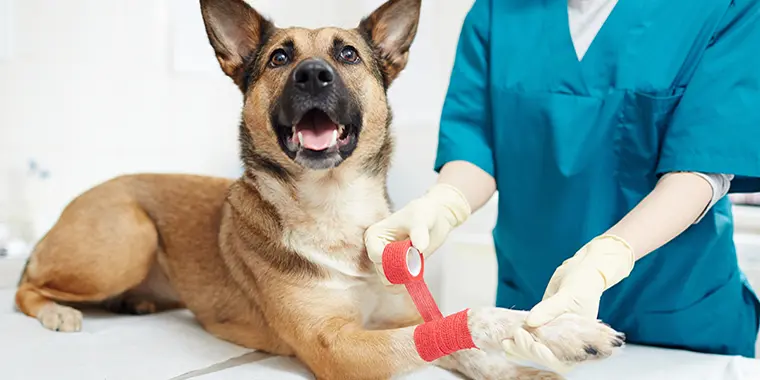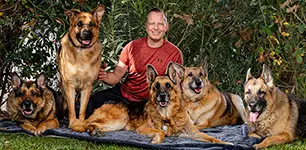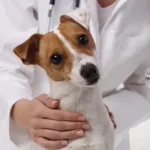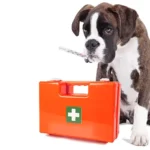
Accidents happen, and it is better to be prepared. This includes putting together a great first-aid kit for your dog. Many dog first aid kits are on the market, and I rarely see an inherently bad one. However, once you are in an emergency with your dog and only have one of these minimalist first aid kits, you wish you had planned better.
I have dealt with my fair share of emergencies and discovered which items are most valuable to have on hand and which are less useful. This article covers what I have in my mobile dog first aid kit—I also have a really big one for people and dogs, but that is not something I would want to carry around. The first aid kit must be small and light enough to be carried or even attached to your dog’s vest, harness, or pouch but still contain all vital components in case things go wrong.
In addition to outlining what should be included in a good dog first aid kit, I put together a shopping list on Amazon and included the link at the bottom of this article. This allows for a quick and easy way to get everything you need.
1. Equipment
- First Aid Pouch
- Pen Flashlight
- 1 Pair of Shears
- 4 Nitrile Exam Gloves
- 1 K9 Tourniquet
- 2 Small Plastic Bottles
You want to have the right kind of pouch for your canine first aid kit. It should be sturdy, not too big, and lightweight; ideally, it easily attaches to your dog’s vest or pouch. The tactical MOLLE EMT pouch on our list fits that bill. It also includes shears.
A vital piece of equipment hardly any dog first aid bag comes with is a canine tourniquet. Tourniquets help stop a patient from bleeding out if an artery is injured. A dog can bleed to death from a leg wound in under a minute—so can a person. You want a canine tourniquet that fits around your dog’s body to be deployed wherever needed. Human tourniquets are too small and designed for human arms and legs only. A tourniquet can make the difference between life and death. This belongs in every dog first aid kit.
A flashlight to examine wounds, shears to cut gauze, nitrile gloves to protect yourself and your dog during treatment, and the right size of plastic bottles to hold some crucial first aid supplies round out our equipment list.
You can find all products on our Amazon Shopping List.
2. Wound Care Supplies for Your Dog First Aid Kit
- 1 Roll of Waterproof Adhesive Tape
- 2 Rolled Gauze Packs
- 6 Cotton-Tipped Applicators
- 4 Non-Stick Pads
- 2 Injury Wrap Tapes for Pets (1 wide, 1 narrow)
- 1 Vetericyn Plus
- 2 Styptic Powder Viles
- 3 Triple Antibiotic Packets
- 4 Alcohol Prep Pads
- 1 First Aid Booklet
If you have never attended a first aid class by the Red Cross, you absolutely should! A basic understanding of how to clean and care for open wounds and fresh injuries is a valuable life skill. It will teach you how to use all of the listed supplies correctly. The Red Cross also offers specific pet first aid classes. I attended one 15+ years ago, and I highly recommend it.
Dog First Aid Booklet
Having a first aid booklet in your kit is a good idea. Reading it before an incident is an even better idea. These are good references to have available. Getting your fingers on a small useful first aid booklet is worth buying a pre-packaged dog first aid kit. It will include some of the items on our list and can serve as a foundation you only have to add to. The commercial kit on our shopping list was the foundation for our ‘McGiver’ pet first aid kit. It is the Adventure Medical Kits Adventure Dog Series Heeler.
Technology changes everything. The Red Cross now also offers a free pet first aid app for Android and Apple called Pet First Aid: American Red Cross. It is marvelous! It even contains links to YouTube videos with instructions on first aid procedures. The written instructions and pictures will available when you are offline. The videos require data service. So if you are hiking in the mountains, ensure you have access to all information when there is no cell service.
With some basic first aid knowledge, all listed supplies will make immediate sense. Two comments on our list.
Two Special Items
Vetericyn Plus (3oz bottle) is our wound cleaner of choice instead of a simple saline flush. It is also a disinfectant and promotes healing. I use this on myself as well. This stuff is just fantastic. Vetericyn is a clear liquid in a convenient spray bottle. They also make larger ones for in the home, but this 3 oz bottle is perfect for our mobile dog first aid kit. It is a great wound cleaner that isn’t sticky and doesn’t sting. I use this instead of antibiotic cream on new wounds in the beginning. It is a three-in-one product. As such, it helps reduce weight in our first aid pouch. Never carry more than you must.
Styptic powder helps to clot and stops bleeding. If a wound is bleeding profusely, the styptic powder is very helpful in addition to a tourniquet.
You can find all products on our Amazon Shopping List.
3. Poisoning
- 45 ml Food-Grade Hydrogen Peroxide 3% (3 tablespoons)
- 100 grams Food-Grade Activated Charcoal (non-food grade is toxic)
- 1 Large Syringe
- Optional: 1 Universal Animal Antidote Gel (this is a convenient prepackaged activated charcoal product, but you need to carry an applicator gun to use it)
These items are vital dog first aid kit supplies, but I have never seen a commercial pack that included them. Dogs eat things they shouldn’t. If you see them do it, you may be able to stop it. But what if they swallow it, and you know it will harm or even kill them?
Making Your Dog Throw Up
A tablespoon of hydrogen peroxide will make your dog throw up within 5–10 minutes. It may take 2–3 tablespoons with larger dogs, but you always start with one tablespoon first. This is where the plastic bottles I listed above come in. One of them should be filled with 15 ml of food-grade hydrogen peroxide. These particular bottles can be used to squeeze the hydrogen peroxide straight down your dog’s throat. This is important as your dog will not drink this stuff voluntarily.
Prevent Absorption of Toxins
If your dog swallowed something and it is past 15–20 minutes, throwing it up might no longer be an option. If it is toxic, binding it in your dog’s stomach with food-grade activated charcoal will prevent absorption and save its life. This is also one of the main things veterinarians do when a dog comes in with poisoning of some sort. The required amount for your dog is about 1 gram per pound of body weight. You also need water (or, better, Pedialyte) to create a solution and the syringe to shoot it down your dog’s throat. I listed 100 grams above as that will be enough for most dogs. However, if your dog weighs over 100 pounds, you must carry more. You need to carry 1 gram per pound of body weight. Make sure these are part of your dog’s first aid kit.
You can find all products on our Amazon Shopping List.
4. Patient Care
- 1–2 Mylar Rescue Blankets
- 1 Instant Cold Pack
- Optional: 60 ml Rubbing Alcohol (4 tablespoons)
Mylar blankets can keep your dog warm when necessary. You may need to pack two for large dogs.
Cold packs can help with various injuries like insect stings, sprains, and so on.
Rubbing alcohol can help an overheated dog or a dog with heat stroke to cool its body temperature down quickly. This also works on fever. The rubbing alcohol is applied to the paw pads. Another useful dog first aid kit item.
You can find all products on our Amazon Shopping List.
5. Rattlesnake Bites
- 4–5 25mg Benadryl Tables
Rattlesnake poison kills dogs quickly. After a bite, time is of the essence. Veterinarians offer rattlesnake vaccines, but it doesn’t protect your dog from the poison. They are supposed to slow the dog’s metabolism enough to buy you another hour to get antivenom. The problem is it doesn’t work as well as one would hope, and the possible side effects are alarming. Most Veterinarians take their dogs to rattlesnake avoidance training instead.
The Problem with Rattlesnake Vaccines
A recent study tested the effectiveness of rattlesnake vaccines (CAT vaccines). The test included venoms from the Western Diamondback, Northern Pacific, and Southern Pacific Rattlesnake species. These are the most common rattlesnake species in Southern California. The study found improved survival rates and survival time after challenge exposure to Western Diamondback Rattlesnake venom. However, it may only offer limited protection against Northern Pacific Rattlesnake venom. It provided no significant benefit with Southern Pacific Rattlesnake venom. Read the comparative study on the effectiveness of rattlesnake vaccines for different species of rattlesnakes in the American Journal of Veterinary Research, March 2015, Volume 76, Number 3, Pages 272-279.
Rattlesnake avoidance training is the best way to avoid the problem altogether, but what if it happened anyway?
The Benadryl Alternative
It turns out that Benadryl does what the rattlesnake vaccine is supposed to do much better and more reliably without the common rattlesnake vaccine side effects (this may be the worst dog vaccine in general)—it buys you more time to get to a veterinarian who has antivenom. This belongs in every canine first aid kit. You need to give your dog 1 mg per pound of body weight for this to work. Bring enough to cover all dogs and people in your hiking party. Benadryl tablets usually come in 25mg size; plan accordingly.
Also, think about how you get your dog to swallow them when necessary. You can usually get them down their throat with water. Pill pockets would be easier but your dog may not eat them after a rattlesnake bite. You have to be prepared to do it manually.
You can find all products on our Amazon Shopping List.
6. Bug Bites Tools for Your Dog First Aid Kit
- Blank PVC Card (or an expired Credit Card)
- Protick Remedy
PVC Cards are a great way to scrape insect singers off your dog’s (or your own) skin; old credit cards also work.
Protick Remedy is a type of tweezer that completely removes ticks and other bloodsuckers from your dog.
You can find all products on our Amazon Shopping List.
7. Paw Care
- Musher’s Secret
- Paw Soother
Contrary to popular belief, dog paws are not indestructible. Musher’s Secret is a great way to prepare your dog’s paws before a hike and protect them better from rough terrain.
Paw Soother is for after-care once paws get rough. Musher’s Secret could also be used as a second-best option.
This is our mobile dog first aid kit. I hope it inspires you to make your own. Your dog will be grateful.
You can find all products on our Amazon Shopping List.






